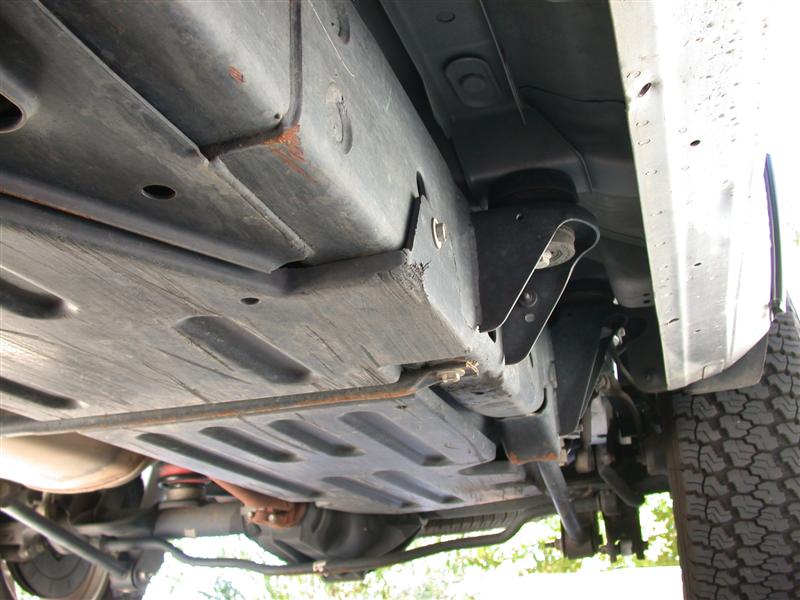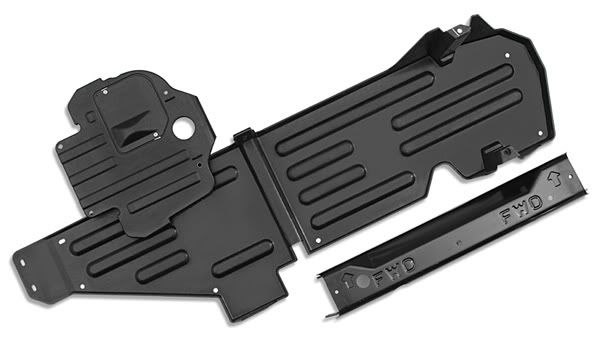First a little back story to explain why I decided it was need:
In Sept. 2011 I attended the 2011 Dakota Territory Challenge. It is a 3 day wheeling event over the Labor Day holiday.
On the third day of the event, while driving over some rock, the rear of my vehicle slid sideways off of the rock and put the decent sized rock between the frame rails. This had some of the guides giddy as they could rotate my TB back and forth while it was hung up on the rock. A few well placed smaller rocks allowed me to drive off, and not seeing any leaking, we continued the days drive.
Later that evening back at camp I took a look at the damage resulting from said rock. Fuel gauge worked, no fuel pump issues, so I drove home and took photos once there after the event.



Suffice it to say, I was glad that little tube ran across the frame where it did and kept the rock from doing any further damage to the fuel tank.
Fast forward to the following year.
I make plans to attend the 2012 Dakota Territory Challenge. This time taking my wife instead of my best friend. I knew additional protection was going to be required for the vehicle so I had ordered up a set of Trail-Gear Rock Sliders. While waiting for them to arrive, one of the Engineers where I worked was getting ready to move and asked if I would come over and help him finish his Cherokee so he could have it running for when he moved from Wyoming down to Colorado. While helping him out, I was able to test fit a set of Bushwacker Cut-Out Fender Flares that he had on hand for his jeep. I gave up on that idea as they would require extensive modification to make them fit on a GMT360.
Anyways, we visit over the next few weekends and he begins telling me about his Ford Diesel. Some of the upgrades and what not and I found out he had upgraded his fuel tank to a larger aftermarket unit. I asked if he still had the factory skid plate for his original fuel tank laying around and if he'd mind if I snagged it from him before he moved. He said no problem and we loaded it up on of the last days before he left.
Here is a link with a diagram of the part he gave: http://www.ebay.com/itm/FORD-OEM-AL3Z9A147A-Fuel-System-Skid-Plate-/321337070670?pt=Motors_Car_Truck_Parts_Accessories&hash=item4ad12e944e&vxp=mtr The piece that I am referring to is #20 in the diagram. Though initially listed as a cover for 99-04 Diesel trucks, the part # is listed up through at least 2012 model year vehicles. Pricing seems to vary online, but if you can pick on up cheap enough, here is what you'll end up with.

Pictured is the OEM part at the shop I was at installing my sliders in preparation for 2012 DTC.
First thing to do is prep to fit for a GMT360. We started by grinding off the rivets for the factory brackets:

Once ground and punched out, you have a bare plate that needs a little further prepping to work. Start by taking a crescent wrench or a hammer and flatten out the bend area located on the left side of the bare plate in the picture below, it is near the factory bracket that was removed.

Now that the plate is prepped, feel free to clean and paint your plate as needed. Mine was in good shape, so I just cleaned the dirt off from the surfaces. After spending some time with the bare plate under my Trailblazer, we began to formulate a mounting system. We made 2 brackets. The first would use the same mounts as the old thin tube that ran from one frame rail to the other then an arm to mount up near the fuel tank strap that holds the tank in place. The second would use an unused factory mount on the inboard side up near the rear of fuel tank. After some cutting of 1.5"X.375 strapping, a lot of measuring and bending, some paint and a set of bolts later we came up with:

The fore bracket used the same 2 holes as our little tube does, and the bolted on additional bracket mounts up with a larger bolt to the same mount as the front strap as the fuel tank. The aft bracket is simply bent as needed and holes drilled to make use of already existing factory locations as well.
The completed product ready to install:

Short of drilling holes in the strapping, no additional holes required drilling. Actually we used a press to put the holes in place, but most will require a drill to make the holes. Here is the inbound rear mounting location already in place on our vehicles, not being used just waiting for a skid plate bracket, it sits near the evap canister:

It was almost as if our trucks were supposed to have an actual skid plate in place and they just never followed through with full implementation.
Anyway, I did not take any pictures of it in place unmolested for some reason. But I did take a few pictures of how it held up after attending the 2012 DTC.


Appears that the front bracket held up better than the little tube did, though it did bend back some.


The rear bracket also took a few hits, but seemed to hold out well.
Things I don't like about this set up: Nut and bolt threads hanging down below the brackets. not much I could do in this instance. Used what I had on hand and didn't want them to press up into the tank if I got hung up on the skid. Welded nuts on the top of the plate and flat head bolts would work better.
The upside: little to no modification to the Vehicle itself. The size fits quite well, not as wide as our fuel tank, but wide enough to give the protection needed. Price, at least for me was great. Managed to get the Ford skid free and hardware to make up new brackets and labor for the cost of dinner. I'm sure with the way the brackets are damaged, I would have had similar or additional damage to or near the fuel tank as the year prior if I did not have it in place. Did I mention my wife drove 2 of the 3 days this go around?
So that's it on how to convert a Ford Diesel fuel tank skid over to work on a GMT360. If anyone would like additional photos, once it warms up and I can climb underneath my truck again, I will be happy to take more. Also, post any questions below and I'll try and answer as best as I can.



